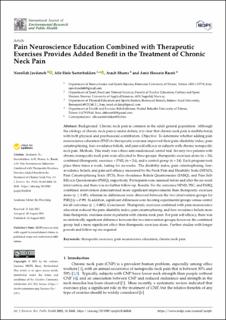| dc.identifier.citation | Javdaneh, N., Saeterbakken, A. H., Shams, A., & Barati, A. H. (2021). Pain Neuroscience Education Combined with Therapeutic Exercises Provides Added Benefit in the Treatment of Chronic Neck Pain. International Journal of Environmental Research and Public Health, 18(16): 8848. | en_US |
| dc.description.abstract | Background: Chronic neck pain is common in the adult general population. Although the etiology of chronic neck pain is under debate, it is clear that chronic neck pain is multifactorial, with both physical and psychosocial contributors. Objective: To determine whether adding pain neuroscience education (PNE) to therapeutic exercises improved their pain–disability index, pain catastrophizing, fear–avoidance beliefs, and pain self-efficacy in subjects with chronic nonspecific neck pain. Methods: This study was a three-arm randomized control trial. Seventy-two patients with chronic nonspecific neck pain were allocated to three groups: therapeutic exercises alone (n = 24), combined (therapeutic exercises + PNE; (n = 24), and a control group (n = 24). Each program took place three times a week, lasting for six weeks. The disability index, pain catastrophizing, fear–avoidance beliefs, and pain self-efficacy measured by the Neck Pain and Disability Scale (NPAD), Pain Catastrophizing Scale (PCS), Fear–Avoidance Beliefs Questionnaire (FABQ), and Pain Self-Efficacy Questionnaire (PSEQ), respectively. Participants were assessed before and after the six-week intervention, and there was no further follow-up. Results: For the outcomes NPAD, PSC, and FABQ, combined intervention demonstrated more significant improvements than therapeutic exercises alone (p ≤ 0.05), whereas no differences were observed between the two intervention groups for PSEQ (p = 0.99). In addition, significant differences were favoring experimental groups versus control for all outcomes (p ≤ 0.001). Conclusion: Therapeutic exercises combined with pain neuroscience education reduced the pain–disability index, pain catastrophizing, and fear–avoidance beliefs more than therapeutic exercises alone in patients with chronic neck pain. For pain self-efficacy, there was no statistically significant difference between the two intervention groups; however, the combined group had a more significant effect than therapeutic exercises alone. Further studies with longer periods and follow-up are required. | en_US |

